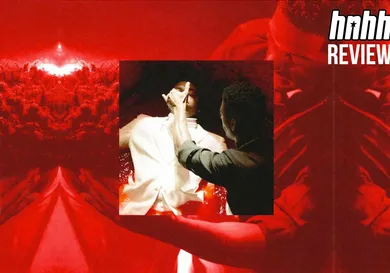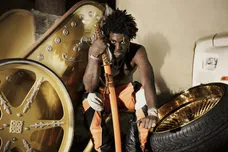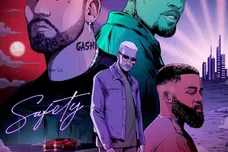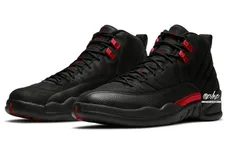Last year was arguably one of the more rewarding years for Florida rapper Kodak Black as far as his musical career went. The now 21-year old Bill K. Kapri released his debut album Painting Pictures as well as the sprawling Project Baby 2 to much fanfare and commercial success, while finding himself in and out of incarceration, as well as racking up further legal issues. Naturally, this year has been a considerable slow-down, with only his R&B project Heartbreak Kodak released at the beginning of this year, whetting fans’ appetites until his last-minute album release, Dying to Live. At 16 tracks, it's a curious new chapter to the career of Kodak Black, as we find him attempting to revisit his darker moments of introspection and develop further as a rapper while still continuing to make himself one of the hottest ‘new stars’ in the rap game. But how well does the young rapper succeed on his sophomore album?
As opposed to last year’s Painting Pictures, a majority of the production on Dying to Live goes for beats that convey deeper, emotional sounds, hanging over the album in a gloomy fashion. Given such a moody palette obsessed with vibes, it’s no wonder that the album has already earned a co-sign from Drake long before the general public has weighed in on their approval of Kodak’s newest offering. This weighty, serious tone suits Kodak’s strengths more often than the more pleasant or cleaner sounds, yet it can manage to feel like an oppressive and laborious trek through an endlessly lilting drift. Exceptions certainly exist on Dying to Live such as the Travis Scott and Offset-assisted single “ZEZE” or the Cash Money-style throwback jam of “Identity Theft,” but for the most part you can expect a smoked out mid-tempo vibe to wade through while Kodak does his best to wax poetic. That said, the beats in question are top notch efforts by Kodak’s returning core team of Ben Billions, Dyryk & Rex Kudo as well as support from hitmakers such as D.A. Doman, London on tha Track, Southside and many others. With not a clear ‘dud’ in sight, the production side of Dying to Live is respectable but remains one of the many points where listeners can feel either immersed or repelled while engaging.
Confoundingly, the album feels split between the directions indicated on both Project Baby 2 and Painting Pictures respectively, for better or worse. On one hand, Kodak appears to be attempting to mimic his idea of what a commercial rapper should be, allowing collaborators who guarantee industry recognition without the more obvious attempts at mainstream compromise. “ZEZE” isn’t Kodak particularly focused or interesting, but the repetitive steel drum hooks as well as Travis’ chorus are perfectly suitable as far as commercial singles go. Yet the other attempts at radio-friendly Kodak material are frustratingly blank; whether it’s the dull “Gnarly” in which of all people Lil Pump outraps and out boneheads Kodak over the trance-tinged synths, or “Moshpit” which consists of forgettable production and a Juice WRLD feature you could’ve easily mistaken as a miscredited Post Malone verse. If it's any condolence, Kodak Black has openly admitted that these particular collaborations were all a ploy to boost his streaming numbers, he too is not enthralled with them. At the end of the day, what helps Dying to Live improve where Painting Pictures often lacked is it's full-on dives into the more morose and dark narcissism which has often proved to be the most fruitful arena of exploration for Kodak.
This isn’t to say that the ‘dark’ records aren’t without their missteps either. Once you get past the fuzzed out, gothic string samples on “Take One,” the rapping is oddly flat for all the many threats Kodak tries to convey. Likewise on the London on tha Track produced “This Forever,” it’s a rare time when Kodak fails to deliver the emotional depth mirrored by the ethereal beat. However, when the depressive swirls of “Testimony” or the ravey sub-bass of “Transgressions” kick in during that first half of the album, you can hear the urgency in Kodak’s rhymes and delivery from miles away. While those two are unusual moments of excessive personality during the ‘conservative’ first half of the album, they quickly give way to a dense second half which is familiar territory for fans of Project Baby 2, as Kodak dives headfirst into his usual blend of street imagery and self-obsessed agonizing. And while the second half isn’t without it’s disruptive moments (“Calling My Spirit” features some rather strained use of autotune and “Could Of Been Different” features Kodak rapping at uncharacteristic speeds and rhythms that could probably throw off longtime fans and casual listeners alike), hearing records such as “Malcolm X.X.X.,” “In The Flesh” or “From the Cradle” is hearing Kodak at his most potent.
While Dying to Live doesn’t feel like the strongest release by Kodak, it feels like Kodak’s strongest ‘studio album’ to date and hints that his development is not yet finished. Given the rapper’s inability to keep himself out of trouble, there’s little guarantee that he has the chance to fully realize his potential despite all the soul-searching that he commits to on wax. Furthermore, it seems that while Kodak is learning fairly well how to promote himself as a singles artist, he would possibly do even better to make radio conform to him and showcase the kind of music he does so magnificently. In the meantime however, Dying to Live demonstrates that despite a comparatively calm output in 2018, Kodak Black remains one of the top-tier of his generation and is increasingly preparing to assume such a level among the entire rap game.







